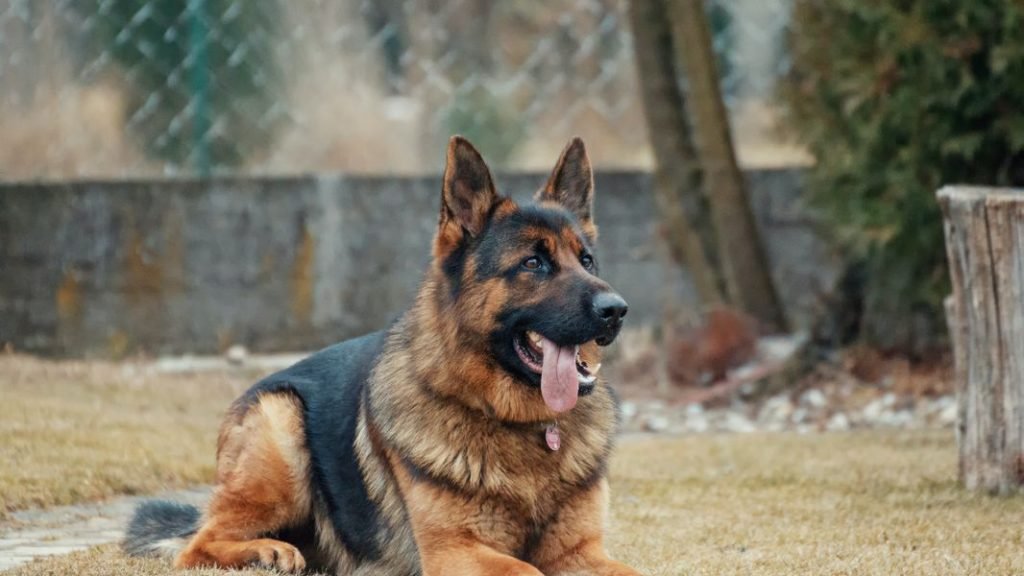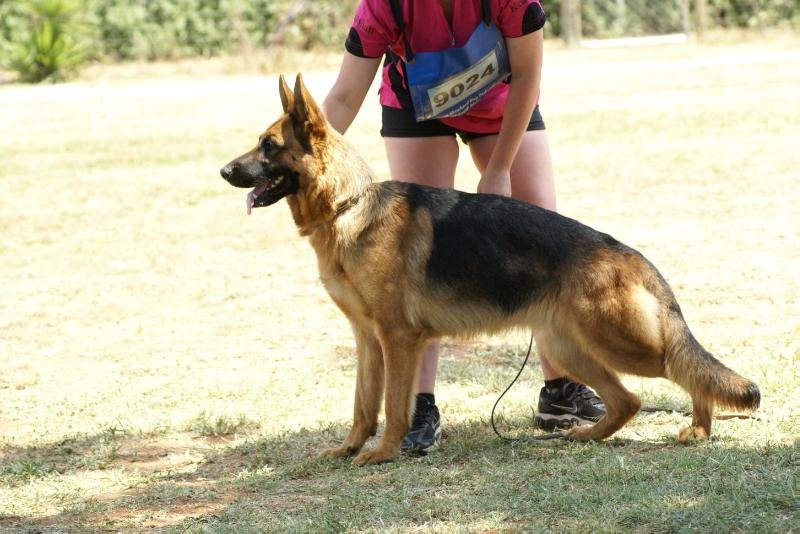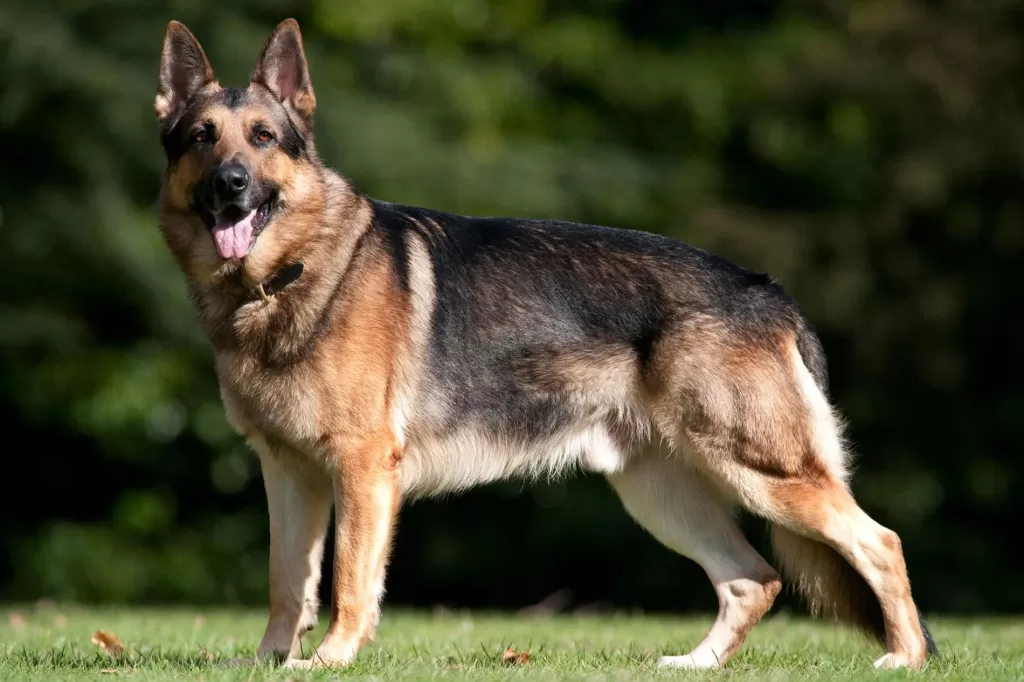Is My Female German Shepherd Dog on Heat? How do I know? What can I do? Intact female dogs (non-surgical dogs), and sexually mature ones, prepare to breed and reproduce during estrus, “in the heat” or “season”, occasionally during the “cycle”.
Table of Contents
On average, a full dog reproduction heat cycle takes up to 6 months, resulting in 2 heat cycles for most female GSDs each year.

Learn about all aspects of your dog’s health and behavioral life, prepare accordingly and you both should have a long and healthy life together.
When does a dog experience its first estrus?
Dogs typically experience their first estrus, also known as the “heat” cycle, at around six to twelve months of age, although there can be considerable variation depending on the breed and individual factors. Smaller dog breeds tend to go into their first heat cycle earlier, often closer to six months, while larger breeds may experience it later, closer to twelve months or even beyond.
During the estrus cycle, which typically lasts for about two to three weeks, female dogs exhibit various behaviors and physical changes. These may include:
- Swelling and Discharge: The vulva may swell, and a clear to bloody discharge is often observed.
- Increased Urination: Female dogs tend to urinate more frequently to mark their territory and signal their reproductive availability.
- Changes in Behavior: Behavioral changes can vary, but common signs include restlessness, increased affection, and a heightened interest in male dogs.
- Flagging: When a female is ready to mate, she may “flag” her tail to the side to allow for easier access to her reproductive organs.
- Attracting Males: Male dogs may become more interested in her scent and may display increased attentiveness and attempts to mate.
It’s crucial to note that while the first estrus may occur at a relatively young age, it is not advisable to breed a dog during their first heat cycle. Responsible breeding should only be considered when the dog is older and has undergone necessary health screenings.
Additionally, it’s important to consult with a veterinarian to discuss the best timing for spaying if you do not plan to breed your female dog, as spaying can prevent unwanted pregnancies and reduce the risk of certain health issues. Always consult with a qualified veterinarian for personalized guidance regarding your dog’s reproductive health.
How often do dogs get into heat?
Dogs typically go into heat, also known as estrus, approximately every six months, although there can be some variation among individual dogs and breeds. Estrus is a regular part of the reproductive cycle for intact (non-spayed) female dogs and is essential for their ability to reproduce.
Here’s a breakdown of the canine estrus cycle:
- Proestrus: This is the first stage of the cycle and usually lasts for about 7 to 10 days. During this time, female dogs may experience a swollen vulva and a bloody discharge. However, they are not yet receptive to mating.
- Estrus: Following proestrus, the estrus phase begins and typically lasts for around 7 to 10 days. Female dogs become receptive to mating during this stage, and their discharge may change from bloody to straw-colored. They may also display specific behaviors to attract males.
- Diestrus: After estrus, diestrus follows, which is a period of about 60 to 90 days. If the dog does not become pregnant, her reproductive cycle will return to proestrus, and the cycle will repeat itself.
- Anestrus: Anestrus is the period between one cycle and the next, lasting approximately 4 to 5 months. During this time, female dogs are not in heat, and their reproductive system is in a resting phase.
It’s essential to note that the length and intensity of each phase can vary between individual dogs and breeds. Smaller dog breeds often have shorter cycles, while larger breeds may have longer ones. Additionally, some dogs may have irregular cycles.
If you’re a dog owner and do not intend to breed your dog, spaying is a common and responsible option to prevent unwanted pregnancies and certain health issues. It’s advisable to consult with a veterinarian for personalized guidance on the timing of spaying and reproductive health management for your dog.
Read our article on the Dog Heat Cycle Calculator for a better understanding
How long does a dog stay in the heat?
The time at which male dogs are attracted to the female is variable, about 18 days. However, females receive only half as much as males at this time.
Female German Shepherds, also known as bitches, usually have their first heat cycle at 6 to 12 months of age.
Sometimes, females may not have their first seasonal estrous cycle until they are 12 months old or older, depending on the particular dog.
However, keep in mind that this information is very general and not all female dogs follow these exact patterns.
Also Read: 4 Tips for Dog Grooming Equipment maintenance and success
Overall, the heat cycle pattern of each female female dog is relatively average, length-wise, but the length of the heat cycle may vary from female to female when the female German Shepherd goes into the heat.

In most cases, the average female German Shepherd Dogs heat cycle lasts 3 to 4 weeks. Some female German Shepherds may enter the estrus as early as every 4 months, while others may only do so once a year.
Some dogs’ heat cycles, similar to those of human females, may be shorter than average, while other dogs may have longer (4 weeks or more).
Keep these important points in mind regarding your female GSD heat and her annual heat cycles and prepare accordingly.
First, suppose your dog stays in the “season” for at least 21 days, perhaps longer, which changes due to your own female heat cycle.
Second, and most importantly, keep in mind that conception is most likely to occur in the middle section of your GSD heat cycle – usually 7 to 14 days after the start of the heat cycle.
Third, you have to confine your girl for the entire heat cycle – at least 21 days or more, depending on your particular bitch, to make sure no accidental intercourse takes place.
Whether you keep her indoors or out, you need to make sure her environment is “Romeo Proof”. And trust me, you have to think about everything, because an interested man is very alert to come into a woman’s area if he is in the heat.
These guys tend to dig, dig, or penetrate into any area. If your girl is in an area with any kind of weaknesses, trust me, “Romeo” will find them, go inside, and raise them if your girl likes.
If you have any questions about your female GSD, consult your veterinarian or breeder – especially if your dog’s Hot Wheels do not seem “normal”. Cycling problems in female dogs are often an early indicator of other or more serious health problems.
Is my female German Shepherd in the heat? How can I tell?
Understanding the heat behavior in female German Shepherds is essential for responsible dog ownership. When a female German Shepherd is in heat, also known as estrus, there are several physical and behavioral changes that can be observed:
The first stage – Proestrus
The appearance of vaginal bleeding, swelling of the vagina, and an increase in urination (yes, females can identify their territory, especially when it is hot).
The most noticeable thing when you have a female GSD in the heat is that even if you do not know that your female GSD is hot when the male dogs start hanging around the house.
In this first stage, your female German Shepherd rejects the males. Fertilization does not occur at this time. The average length of proestrus is 9 days.
Stage II – Estrus
The time allowed for a female dog to breed with a male. This time is also known as the “Standing Heat” and lasts anywhere from 4 to 21 days, depending on the individual German Shepherd Dog.
A specific behavior to watch out for during this time is called “flagging”, which lasts between 4 and 7 days.
Your dog can lift his tail and/or rub the back end of her against various objects such as walls or fencing.
This is just an indication that your girl is getting ready for adoption. Ovulation occurs during this flagging phase.
As with any female GSD in the heat, dark red, bloody vaginal discharge will eventually change to a lighter shade of red over time.
In most dogs, once this vaginal discharge turns brown or grassy, the dog is very ready to accept males and breed.
Stage III – Metestrus
This is the stage of preparing the uterus for pregnancy and is easy from 4 to 14 days. False pregnancies often occur during this time. Fertilized eggs can take up to a week to attach themselves to the uterine wall if fertilization occurs.
Overall this phase averages 7 days. Keep in mind that this time interval will remain the same even if the dog is pregnant. If fertilization does not occur, this stage returns to the anestrus, which is the fourth stage.
Fourth stage – Anestrus
Rest period between heat, usually up to 5 or 6 months. If you decide to know exactly what stage your female GSD is at, your veterinarian can easily help you diagnose it.
Scientifically your veterinarian can analyze vaginal cells under a microscope (cytology), as well as to measure the levels of progesterone in your dog’s bloodstream.
There is no point in having a puppy litter before your female German shepherd looks after her. In fact, if you spy on your dog earlier, you are eliminating more health risks to her, such as breast and other cancers or pyometra.
In fact, if you spay the dog before her first heat cycle, you will actually give her all the health benefits associated with the spawning process.
If you do not want to raise your GST bitch, you should really consider spaying her and there are very good reasons why.
Why Should I Spay My Dog?
Leaving the toll aside, giving your dog litter and raising children, and allowing the number of homeless animals to be euthanized each year, will allow your dog to coexist irresponsibly.
(This does not apply to those who are active in dog sports activities, and have knowledge of caring for pregnant dogs and nursing puppies.)
Although many people have heard, there are health benefits to allowing litter in front of the dog. Spade, this belief has not been proven. In fact, the difficulty of giving birth and raising children can lead to premature aging and in some cases death.
It has also been shown that dogs exposed before the first heat cycle have a much lower risk of developing mammary gland tumors.
How long do female German shepherds bleed when in heat?
Certainly, the duration of bleeding, also known as the “estrus” phase, for female German Shepherds during their heat cycle can vary from dog to dog. On average, it usually lasts for about 7 to 14 days. However, it’s important to note that this timeframe can be shorter or longer depending on the individual dog.
Real-life scenarios often demonstrate this variation. For instance, some female German Shepherds may experience a relatively short estrus phase, lasting just a few days, while others may have a more extended cycle that can last up to three weeks.
Factors contributing to these differences can include the dog’s age, overall health, and breed, as well as individual hormonal variations. It’s essential for dog owners to pay close attention to their pet’s specific behavior and physical signs during this time to determine when they are in estrus and when it ends.
Monitoring these signs, such as the changing color and consistency of the vaginal discharge, behavioral changes, and responses from male dogs, can help in understanding the unique timing and duration of estrus for a particular female German Shepherd. Always remember that each dog is different, and consulting with a veterinarian for guidance on managing your dog’s heat cycle is advisable, especially if you plan to prevent unwanted pregnancies.

